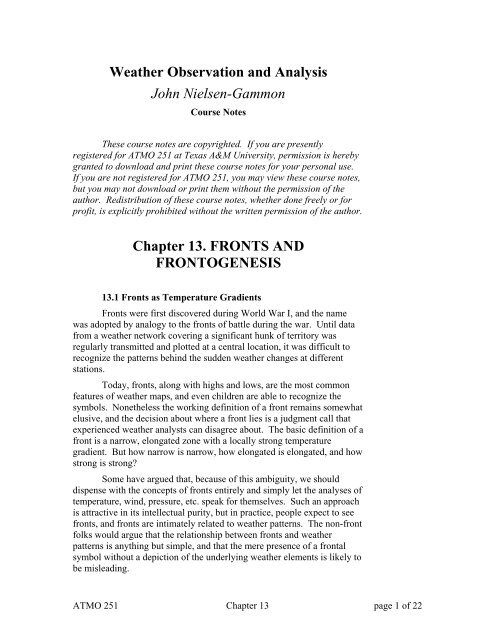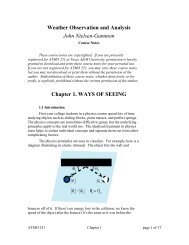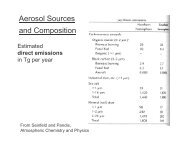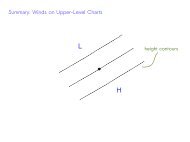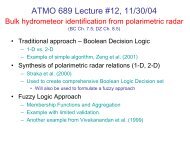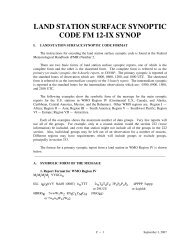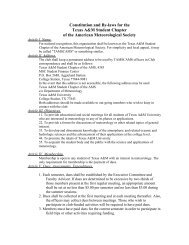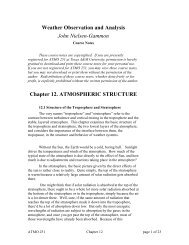Chapter 13: Fronts and Frontogenesis - Texas A&M University
Chapter 13: Fronts and Frontogenesis - Texas A&M University
Chapter 13: Fronts and Frontogenesis - Texas A&M University
Create successful ePaper yourself
Turn your PDF publications into a flip-book with our unique Google optimized e-Paper software.
Weather Observation <strong>and</strong> Analysis<br />
John Nielsen-Gammon<br />
Course Notes<br />
These course notes are copyrighted. If you are presently<br />
registered for ATMO 251 at <strong>Texas</strong> A&M <strong>University</strong>, permission is hereby<br />
granted to download <strong>and</strong> print these course notes for your personal use.<br />
If you are not registered for ATMO 251, you may view these course notes,<br />
but you may not download or print them without the permission of the<br />
author. Redistribution of these course notes, whether done freely or for<br />
profit, is explicitly prohibited without the written permission of the author.<br />
<strong>Chapter</strong> <strong>13</strong>. FRONTS AND<br />
FRONTOGENESIS<br />
<strong>13</strong>.1 <strong>Fronts</strong> as Temperature Gradients<br />
<strong>Fronts</strong> were first discovered during World War I, <strong>and</strong> the name<br />
was adopted by analogy to the fronts of battle during the war. Until data<br />
from a weather network covering a significant hunk of territory was<br />
regularly transmitted <strong>and</strong> plotted at a central location, it was difficult to<br />
recognize the patterns behind the sudden weather changes at different<br />
stations.<br />
Today, fronts, along with highs <strong>and</strong> lows, are the most common<br />
features of weather maps, <strong>and</strong> even children are able to recognize the<br />
symbols. Nonetheless the working definition of a front remains somewhat<br />
elusive, <strong>and</strong> the decision about where a front lies is a judgment call that<br />
experienced weather analysts can disagree about. The basic definition of a<br />
front is a narrow, elongated zone with a locally strong temperature<br />
gradient. But how narrow is narrow, how elongated is elongated, <strong>and</strong> how<br />
strong is strong?<br />
Some have argued that, because of this ambiguity, we should<br />
dispense with the concepts of fronts entirely <strong>and</strong> simply let the analyses of<br />
temperature, wind, pressure, etc. speak for themselves. Such an approach<br />
is attractive in its intellectual purity, but in practice, people expect to see<br />
fronts, <strong>and</strong> fronts are intimately related to weather patterns. The non-front<br />
folks would argue that the relationship between fronts <strong>and</strong> weather<br />
patterns is anything but simple, <strong>and</strong> that the mere presence of a frontal<br />
symbol without a depiction of the underlying weather elements is likely to<br />
be misleading.<br />
ATMO 251 <strong>Chapter</strong> <strong>13</strong> page 1 of 22
Even the basic definition of a front includes many non-fronts. For<br />
example, imagine a coastline separating a warm l<strong>and</strong> surface from a cold<br />
ocean. The air above the coastline would meet the criterion of a narrow,<br />
elongated zone of locally strong temperature gradient. Yet nobody would<br />
consider it to be a true front.<br />
While this argument rages, we will attempt to construct a working<br />
definition of fronts that will serve us well enough for the time being. A<br />
synoptic-scale front is an air mass boundary that extends up into the<br />
troposphere. It includes at least a locally enhanced temperature gradient<br />
<strong>and</strong> a vector wind shift.<br />
A vector wind shift means that the horizontal wind vectors on one<br />
side of the front are different from the horizontal wind vectors on the other<br />
side of the front. At ground level, the wind shift is either purely<br />
convergent or both convergent <strong>and</strong> cyclonic. Above ground level, the<br />
wind shift is only cyclonic.<br />
ATMO 251 <strong>Chapter</strong> <strong>13</strong> page 2 of 22
The front must also include a change in pressure gradient<br />
consistent with that change in wind. Usually the pressure pattern will take<br />
the form of a trough. If there are different air masses on either side of the<br />
front, there may also be a dewpoint gradient. The front may also include<br />
variations in weather or cloud cover.<br />
The inclusion of “synoptic scale” means the front must be at least<br />
several hundred kilometers long. Simple gust fronts, outflow boundaries,<br />
<strong>and</strong> sea breezes are excluded from this category because they are generally<br />
too short or too shallow to be considered synoptic-scale fronts. Indeed,<br />
there are only five kinds of synoptic-scale fronts: warm fronts, cold fronts,<br />
stationary fronts, occluded fronts, <strong>and</strong> upper-level fronts.<br />
<strong>13</strong>.2 Surface <strong>Fronts</strong><br />
Except for upper-level fronts, all the front types listed in the<br />
previous paragraph are surface fronts. They are called surface fronts even<br />
ATMO 251 <strong>Chapter</strong> <strong>13</strong> page 3 of 22
though they extend up above the planetary boundary layer, because the<br />
strongest wind variations <strong>and</strong> temperature gradients tend to be at the<br />
surface. Surface fronts typically weaken with height, <strong>and</strong> while it is<br />
possible for surface fronts to connect with upper-level fronts <strong>and</strong> thereby<br />
extend through the entire depth of the troposphere, most surface fronts<br />
peter out near the 600 mb to 800 mb level.<br />
Surface fronts have specific structural characteristics that are<br />
important for underst<strong>and</strong>ing the weather associated with them. The<br />
following discussion applies specifically to variations of weather elements<br />
observed at ground level.<br />
First, the zone of strong temperature gradient is generally much<br />
wider than the zone over which the wind shift occurs. In other words,<br />
while the temperature gradient zone is rather narrow, the wind shift is very<br />
narrow.<br />
Second, the wind shift, which is collocated with (or at worst within<br />
a few miles of) the pressure trough, is at the warm edge of the temperature<br />
gradient.<br />
Third, if there’s a dewpoint change across the front, the dewpoint<br />
change tends to be even more rapid than the temperature change.<br />
Fourth, while there’s often cloudiness <strong>and</strong> precipitation associated<br />
with cold fronts, they can occur on either side of the front, well ahead of<br />
the front, or not at all. Warm fronts are a bit better behaved: if there’s to<br />
be rain or snow associated with a warm front, it will usually be found<br />
ahead of it, on the cold side. The weather associated with stationary fronts<br />
<strong>and</strong> occluded fronts is similar to that associated with warm fronts.<br />
ATMO 251 <strong>Chapter</strong> <strong>13</strong> page 4 of 22
While they tend to have certain distinguishing characteristics,<br />
technically the only absolute difference between warm fronts <strong>and</strong> cold<br />
fronts are the nature of the change of temperature as the front passes.<br />
Warm fronts bring warmer temperatures, while cold fronts bring colder<br />
temperatures. Even in this absolute sense, exceptions can occur if, for<br />
example, a cold front passes on a calm night or low clouds are present<br />
ahead of a cold front during daytime; both can cause temperatures to<br />
temporarily rise when a cold front passes.<br />
The surface wind <strong>and</strong> pressure usually tell which way a front is<br />
moving: if the average of the winds on both sides of the front would carry<br />
the front in a particular direction, that’s usually the way the front will<br />
move. Using isobars you don’t even have to estimate an average: if<br />
isobars pass through a front, the direction of the geostrophic wind tells you<br />
the direction of frontal motion.<br />
A stationary front is a front that is not moving much. No fronts are<br />
perfectly stationary, so how much can a stationary front move <strong>and</strong> still be<br />
stationary? A basic rule of thumb is about five miles per hour, or about<br />
two degrees of latitude per day.<br />
At an occluded front, the air ahead of a warm front meets the air<br />
behind a cold front. Usually this situation is found near surface low<br />
pressure systems, where an occluded front can extend from the vicinity of<br />
a low pressure center to an intersection point between the warm <strong>and</strong> cold<br />
fronts. In most cases, the cold front is actually riding up over the top of<br />
the warm front, so the occluded front should be drawn as an extension of<br />
the warm front. Since both the warm front <strong>and</strong> cold fronts have<br />
temperature gradients, there are two temperature gradients associated with<br />
an occluded front: one ahead of the front <strong>and</strong> one behind. The front itself<br />
ATMO 251 <strong>Chapter</strong> <strong>13</strong> page 5 of 22
lies along the axis of warmest temperature <strong>and</strong> is also marked by a trough<br />
<strong>and</strong> a wind shift.<br />
All warm fronts tilt forward toward the colder air. Cold fronts are<br />
not so systematic. While most tilt backward toward the colder air, some<br />
tilt forward. Slopes of warm <strong>and</strong> cold fronts vary widely, even within the<br />
same front.<br />
<strong>13</strong>.3 Upper-Level <strong>Fronts</strong> <strong>and</strong> Split <strong>Fronts</strong><br />
The final type of synoptic-scale front is the upper-level front. True<br />
to its name, upper-level fronts are found in the middle <strong>and</strong> upper<br />
troposphere, but some have been known to extend fairly close to the<br />
surface. Unlike surface fronts, which have their wind shift concentrated at<br />
the warm edge of the front, upper-level fronts have the wind shift <strong>and</strong><br />
strong temperature gradient collocated.<br />
ATMO 251 <strong>Chapter</strong> <strong>13</strong> page 6 of 22
Upper-level fronts are most often found in the vicinity of strong jet<br />
streams. They are typically oriented nearly parallel to the upper-level<br />
winds, <strong>and</strong> tilt toward the cold air.<br />
That cold litany of facts makes upper-level fronts seem rather<br />
boring. A bit more interesting is the fact that all upper-level fronts are<br />
really narrow tongues of stratospheric air being dragged down into the<br />
troposphere. In a cross section, the high stratification within an upperlevel<br />
front connects directly with the high stratification within the<br />
stratosphere, <strong>and</strong> aircraft observations have confirmed the presence of<br />
stratospheric ozone levels within upper-level fronts.<br />
Upper-level fronts by themselves are not associated with much<br />
surface weather, but they are quite significant for aviation forecasting.<br />
The zone of an upper-level front often features strong turbulence excited<br />
by strong vertical wind shear, so commercial aircraft generally try to avoid<br />
them.<br />
A so-called split front is actually two fronts: a surface cold front<br />
<strong>and</strong> an upper-level front that extends ahead of it. The best way to tell if a<br />
split front is present is from inspection of both surface <strong>and</strong> upper-level<br />
maps, but if only surface maps are available, the evidence for a split front<br />
is a b<strong>and</strong> of moderate precipitation well ahead of the surface cold front,<br />
with low clouds <strong>and</strong> little precipitation associated with the cold front itself.<br />
The back edge of the moderate precipitation generally corresponds to the<br />
upper-level front. If you are expecting the precipitation to always be<br />
along the surface front, a split front can really wreck your forecast.<br />
<strong>13</strong>.4 <strong>Fronts</strong> <strong>and</strong> Wind Shear<br />
According to thermal wind balance, the strong temperature<br />
gradients associated with synoptic-scale fronts should be associated with<br />
strong vertical wind shear. As with all geostrophic vertical shear, the<br />
shear vector (the vector difference between higher-level winds <strong>and</strong> lowerlevel<br />
winds) should be oriented along the isotherms with warmer<br />
temperatures to the right. Since fronts are oriented nearly parallel to<br />
isotherms, the vertical wind shear will be almost parallel to the<br />
temperature gradient too.<br />
The above statements are consistent with what was earlier noted<br />
about upper-level fronts: that they tend to be associated with strong jet<br />
streams <strong>and</strong> be oriented parallel to them. Indeed, upper-level fronts will<br />
typically start on the left side of the jet (facing downwind) <strong>and</strong> slope under<br />
the jet, extending out the right side in the middle troposphere. This puts<br />
the strongest temperature gradient beneath the jet, where it must be if the<br />
wind speeds are to increase rapidly with height up to jet stream level.<br />
ATMO 251 <strong>Chapter</strong> <strong>13</strong> page 7 of 22
With surface fronts, the shear is not so noticeable, not because it is<br />
much weaker but because the temperature gradients <strong>and</strong> temperature<br />
advection seem to attract the most attention.<br />
As an example, consider a cold front oriented northeast-southwest,<br />
with the warmer air to the southeast. Suppose the surface winds behind<br />
the cold front are blowing from the northwest. Behind the surface frontal<br />
position, there must be a strong temperature gradient, so the vertical wind<br />
ATMO 251 <strong>Chapter</strong> <strong>13</strong> page 8 of 22
shear vector must be oriented from southwest to northeast. Add that wind<br />
shear to the surface wind <strong>and</strong> you will get the wind in the low to middle<br />
troposphere. In this case, we expect the wind aloft to be out of the west or<br />
southwest, depending on the strength of the shear <strong>and</strong> how high up we<br />
choose to go.<br />
It is important to note here that the warm air <strong>and</strong> cold air can be<br />
perfectly “content” to sit side by side with each other. The alarmist<br />
statements on various weathercasts about warm <strong>and</strong> cold air clashing with<br />
each other, producing severe weather <strong>and</strong> tornadoes, is hogwash. Just<br />
because you have warm air <strong>and</strong> cold air next to each other doesn’t mean<br />
that the cold air must slide under the warm air <strong>and</strong> the warm air must be<br />
driven up. Sure, the pressure beneath the cold air will be higher than the<br />
pressure beneath the warm air, but for synoptic-scale fronts, there’s<br />
nothing (except surface friction) to prevent the winds to come into<br />
geostrophic balance with the pressure gradient.<br />
Think about it: you’ve seen geostrophic balance enough times to<br />
know that the winds will be blowing parallel to the isobars rather than<br />
blowing from high pressure to low pressure. The strong wind shear<br />
associated with the frontal zone between warm <strong>and</strong> cold air masses is also<br />
a consequence of geostrophic balance. So while the pressure gradient<br />
force might want to cause the cold air to attack the warm air, the Coriolis<br />
force is holding the air in place, keeping it moving parallel to the isobars<br />
<strong>and</strong>, aloft, nearly parallel to the front itself. This zen-like state of balance<br />
is not nearly as exciting as two air masses clashing, but it is much closer to<br />
the truth.<br />
If warm <strong>and</strong> cold air masses don’t clash, then why are severe<br />
weather <strong>and</strong> tornadoes so often associated with them? Pay attention<br />
during the next severe weather outbreak: more than likely, you’ll find that<br />
ATMO 251 <strong>Chapter</strong> <strong>13</strong> page 9 of 22
the severe weather is not confined to the fronts but instead occurs in a<br />
broad swath within the warm sector. And it is the very shear that keeps<br />
the air masses in balance that allows thunderstorms to develop into<br />
rotating supercells <strong>and</strong> occasionally produce tornadoes. The severe<br />
weather is not produced by the two air masses clashing, it is produced by<br />
the two air masses getting along!<br />
<strong>13</strong>.5 Gravity Currents<br />
At the surface, with friction, there will be a tendency for the wind<br />
to blow partly from high pressure to low pressure. Sometimes this can<br />
help cause the leading edge of the front to collapse into a near<br />
discontinuity, with several degrees of temperature difference across a<br />
kilometer or less. Such sharp discontinuities are often found with smaller<br />
fronts as well, such as gust fronts, squall lines, <strong>and</strong> sea breezes.<br />
Once things get so small <strong>and</strong> air passes through them so quickly,<br />
there’s no time for the air to come into geostrophic balance. Instead, a<br />
phenomenon called a gravity current develops. Gravity currents, also<br />
known as density currents, have a sharp leading edge between 100 m <strong>and</strong><br />
1500 m deep, sloping back toward the cold air with a slope of about 1:1.<br />
Along the interface between the warmer <strong>and</strong> colder air, instabilities<br />
develop because of the strong vertical shear there.<br />
Gravity currents are strange beasts because, quite independent of<br />
the sort of dynamical reasoning we have conducted so far, they have a<br />
very predictable velocity. The speed C of a gravity current is given by:<br />
C ≈ U +<br />
θ ′<br />
− g h<br />
θ<br />
ATMO 251 <strong>Chapter</strong> <strong>13</strong> page 10 of 22
where U is the component in the warm air ahead of the gravity current<br />
normal to the gravity current (positive if going away from the gravity<br />
current), h is the depth of the cold air several miles behind the gravity<br />
current, q is the potential temperature within the density current, <strong>and</strong> q’ is<br />
the difference between the potential temperature outside the density<br />
current <strong>and</strong> that within. Plugging in some sample numbers, say a normal<br />
wind of zero, a temperature difference of 6 K <strong>and</strong> a cold air depth of 500<br />
m, the gravity current would be advancing at a speed of about 10 m/s into<br />
the warm air.<br />
Notice that in this example, if the warm-air wind had been blowing<br />
at 10 m/s toward the cold air, the gravity current would be stationary, with<br />
no net velocity. If instead the warm air was blowing away front the<br />
gravity current at 10 m/s, the gravity current itself would be trucking along<br />
at 20 m/s. In effect, the last term in the gravity current equation gives the<br />
speed of the gravity current relative to the warm air.<br />
When the environment of a gravity current is humid, distinctive<br />
clouds often form along the gravity current. A roll cloud is a cloud that<br />
forms due to the upward motion at the head of the gravity current. The<br />
cloud can be composed of air from the warm or cold side of the gravity<br />
current. When such a cloud appears in a satellite image it is called a rope<br />
cloud, a term descriptive of how it looks in a satellite image. A shelf<br />
cloud is a cloud located above the gravity current <strong>and</strong> represents a layer of<br />
humid air aloft that ascends as it passes over the gravity current.<br />
Sometimes a squall line will form along a cold front, <strong>and</strong> the<br />
gravity current speed of the squall line will generally be faster than the<br />
speed of the original cold front. As a result, the squall line will propagate<br />
out ahead of the original cold front. Since the squall line now marks the<br />
leading edge of the strong temperature gradient, the cold front is often<br />
drawn coincident with the squall line. But sooner or later, if it doesn’t<br />
dissipate, the squall line moves so far out ahead of the front that the front<br />
ATMO 251 <strong>Chapter</strong> <strong>13</strong> page 11 of 22
<strong>and</strong> squall line become distinct. It is tricky for a surface analyst to deal<br />
with the simultaneous presence of a cold front <strong>and</strong> squall line.<br />
<strong>13</strong>.6 Deformation<br />
So far, we’ve dealt with several important aspects of a vector field,<br />
both conceptually <strong>and</strong> mathematically. Horizontal divergence is the<br />
tendency of air parcels to move apart, <strong>and</strong> is invariably accompanied by<br />
some combination of upward <strong>and</strong> downward motion to replace the air<br />
that’s moving away. Horizontal convergence is the opposite, <strong>and</strong><br />
mathematically corresponds to negative divergence. As we’ll see in the<br />
next chapter, vorticity is the tendency of air parcels to induce spin about a<br />
vertical axis on imaginary objects embedded in the air; positive vorticity<br />
corresponds to counterclockwise rotation <strong>and</strong> negative vorticity to<br />
clockwise rotation.<br />
The third <strong>and</strong> last possible property of a horizontal vector wind<br />
field is deformation. Deformation is the tendency of air parcels to change<br />
shape. There’s nothing to prevent divergence, vorticity, <strong>and</strong> deformation<br />
to all be present at the same time; pure deformation is when there’s<br />
deformation but no divergence or vorticity.<br />
The mathematical definition of deformation is rather ugly:<br />
D =<br />
⎛ ∂u<br />
∂v<br />
⎞<br />
⎜ − ⎟<br />
⎝ ∂x<br />
∂y<br />
⎠<br />
2<br />
2<br />
⎛ ∂v<br />
∂u<br />
⎞<br />
+ ⎜ + ⎟<br />
⎝ ∂x<br />
∂y<br />
⎠<br />
This is not a misprint: the first term in parentheses has a minus<br />
sign, so it is not divergence. The second term in parentheses would be<br />
vorticity if it did have a minus sign! The similarity of these expressions<br />
makes the whole thing a bit of a nightmare for somebody learning the<br />
subject.<br />
To visualize what pure divergence looks like, let’s simplify things<br />
<strong>and</strong> let each quantity in the second term in parentheses equal zero. Not<br />
only does that simplify the deformation, but it eliminates any possibility of<br />
vorticity. Now, suppose that the rate of increase of u in the x direction is<br />
exactly equal to the rate of decrease of v in the y direction. This makes<br />
the divergence zero as well. Now if we choose (u,v = 0) at the origin, we<br />
get a wind field that looks like the diagram on the following page.<br />
Verify for yourself that there is no divergence here by drawing any<br />
area <strong>and</strong> noting that the amount of air going in some sides equals the<br />
amount of air going out other sides.<br />
Frequently you will see a wind pattern like this on a weather map.<br />
As drawn, assuming geostrophic balance, there would be lower pressure to<br />
the southwest <strong>and</strong> northeast, <strong>and</strong> higher pressure to the northwest <strong>and</strong><br />
southeast. At the center, the winds are calm, yet there is neither a high nor<br />
ATMO 251 <strong>Chapter</strong> <strong>13</strong> page 12 of 22
a low there. The name for this feature is a col or saddle point. The former<br />
name refers to a topographic feature, <strong>and</strong> the latter name refers to the<br />
similar appearance of lines of constant height on a saddle,<br />
As for deformation, imagine an object placed in the middle of this<br />
vector field. The winds will act to stretch the object in the east-west<br />
direction <strong>and</strong> contract the object in the north-south direction. We could<br />
say that the object is being deformed, hence the term deformation.<br />
Notice that we need not place the object at the origin for this to<br />
happen; deformation is present everywhere. No matter where the object is<br />
placed in this vector field, its left <strong>and</strong> right sides will be moving away<br />
ATMO 251 <strong>Chapter</strong> <strong>13</strong> page <strong>13</strong> of 22
from each other <strong>and</strong> its north <strong>and</strong> south sides will be moving toward each<br />
other.<br />
A useful quantity in connection with deformation is the axis of<br />
dilatation. This is the axis along which the imaginary object would be<br />
stretched (or dilated) most strongly. In the example above, the axis of<br />
dilatation is oriented east-west.<br />
Now take the example above <strong>and</strong> rotate it counterclockwise by 45<br />
degrees. Presumably we have not altered the magnitude of the<br />
deformation, since objects would still be stretched or shrunk by the same<br />
amount as before. The axis of dilatation will have rotated too, <strong>and</strong> now<br />
would be oriented northeast-southwest.<br />
With the rotated wind pattern, consider the mathematical terms in<br />
the definition of deformation. After the rotation, each of the derivatives in<br />
the first term in parentheses is suddenly zero! (Don’t take my word for it,<br />
work it out for yourself.) But not to worry, the second term is now<br />
nonzero. Since v increases in the positive x direction, the first derivative is<br />
positive. Since u increases in the positive y direction, the other derivative<br />
is also positive. The lesson here is that there’s really nothing special about<br />
which of the terms contributes to deformation.<br />
ATMO 251 <strong>Chapter</strong> <strong>13</strong> page 14 of 22
<strong>13</strong>.7 Deformation <strong>and</strong> <strong>Frontogenesis</strong><br />
Getting back to our previous example, suppose that the object<br />
being deformed is an imaginary square. (With deformation, it won’t be a<br />
square for long!) Suppose further that two opposite sides of the square lie<br />
in air with different temperatures. What will happen to the temperature<br />
gradient under the action of deformation?<br />
The answer depends on which two sides you pick. If you pick the<br />
east <strong>and</strong> west sides, those sides are becoming farther apart, so the<br />
temperature gradient is getting weaker <strong>and</strong> weaker. If, instead, you pick<br />
the north <strong>and</strong> south sides, those sides are becoming closer together, so the<br />
temperature gradient is getting stronger <strong>and</strong> stronger.<br />
The case of the north <strong>and</strong> south sides of the square having different<br />
temperatures corresponds to isotherms (lines of constant temperature)<br />
running east-west, so that temperature changes as you go north or south.<br />
In the example deformation flow, the winds are causing the isotherms to<br />
become closer <strong>and</strong> closer together. If instead we had isotherms oriented<br />
north-south, the deformation would cause the isotherms to become farther<br />
apart.<br />
Whether the isotherms get closer together (<strong>and</strong> the temperature<br />
gradient becomes stronger) or the isotherms get farther apart (<strong>and</strong> the<br />
temperature gradient becomes weaker) depends on the relative orientation<br />
of the isotherms <strong>and</strong> the axis of dilatation. If the two have a similar<br />
ATMO 251 <strong>Chapter</strong> <strong>13</strong> page 15 of 22
orientation (in the example case, east-west), deformation will cause the<br />
gradient to intensify. In fact, any angle between them less than 45 degrees<br />
will lead to intensification. If the angle is larger, all the way up to a<br />
maximum of 90 degrees, deformation will lead to a weakening<br />
temperature gradient. Right at 45 degrees, deformation will have no<br />
effect.<br />
The process by which the temperature gradient intensifies (<strong>and</strong>, in<br />
mathematical terms, the time rate of change of the magnitude of the<br />
temperature gradient) is called frontogenesis. <strong>Frontogenesis</strong> is one of the<br />
most humorous-sounding words in all of meteorology, just behind<br />
“isodrosotherm”. The converse process, in which the temperature gradient<br />
weakens, is called frontolysis.<br />
Deformation is one of the ways frontogenesis can take place, as<br />
long as the isotherms are oriented properly relative to the axis of<br />
dilatation. Another frontogenetic process is convergence. Both work<br />
well, but for large-scale motions the wind is approximately in geostrophic<br />
balance <strong>and</strong> the convergence of the geostrophic wind is almost zero, so big<br />
synoptic-scale fronts are almost always produced primarily by<br />
deformation.<br />
While it is natural to think of frontogenesis as something that<br />
happens to a front, strictly speaking frontogenesis is something that<br />
ATMO 251 <strong>Chapter</strong> <strong>13</strong> page 16 of 22
happens to an air parcel that may or may not be embedded within a front.<br />
It is actually possible for air to pass through a front, if it experiences<br />
frontogenesis on the way in <strong>and</strong> frontolysis on the way out. This most<br />
often happens with upper-level fronts: air comes in one end of the front<br />
<strong>and</strong> goes out the other.<br />
<strong>13</strong>.8 <strong>Frontogenesis</strong> <strong>and</strong> Vertical Motion<br />
So far we’ve seen that deformation can happen as a result of largescale<br />
wind patterns <strong>and</strong> it can produce frontogenesis. Now, at the scale of<br />
a synoptic-scale front, the wind will be in thermal wind balance, so if the<br />
wind pattern is such as to cause frontogenesis, somehow the vertical shear<br />
must be increasing at the same time. For reasons too convoluted to get<br />
into here, the same horizontal wind pattern that causes frontogenesis<br />
would by itself cause the vertical shear to weaken. So large-scale<br />
frontogenesis tries to throw the atmosphere completely out of balance. So<br />
what else happens that keeps the atmosphere (nearly) in thermal wind<br />
balance?<br />
If the temperature gradient is changing, the pressure gradient must<br />
be changing too. In particular, a stronger temperature gradient means a<br />
stronger gradient at low levels between high pressure on the cold side <strong>and</strong><br />
low pressure on the warm side. While the winds may initially have been in<br />
geostrophic balance, the stronger low-level pressure gradient will cause an<br />
additional acceleration from the cold side toward the warm side at low<br />
levels. This, in turn, implies the development of low-level convergence on<br />
the warm side <strong>and</strong> divergence on the cold side. Which itself means<br />
upward motion on the warm side <strong>and</strong> downward motion on the cold side.<br />
Mass conservation tells us that aloft there must be divergence on the warm<br />
side <strong>and</strong> convergence on the cold side, so the air would be blowing from<br />
warm to cold aloft. We’ve actually described a complete vertical<br />
circulation cell, with low-level air moving from cold toward warm, rising,<br />
moving aloft back toward cold, <strong>and</strong> sinking.<br />
Now stay with me. The horizontal winds just described imply a<br />
Coriolis force directed toward the right of the winds. Since the new winds<br />
at the surface <strong>and</strong> aloft are in opposite directions, so too are the associated<br />
Coriolis forces. And the acceleration in response to the new Coriolis<br />
forces leads to an increase of shear, just the sort of thing we need to keep<br />
the atmosphere close to thermal wind balance.<br />
Meanwhile the vertical motions just described involve the air on<br />
the warm side of the front rising, so the air over there would be getting<br />
cooler. On the cold side, the subsidence leads to warming. On the whole,<br />
the temperature gradient would be weakening because of this vertical<br />
circulation.<br />
ATMO 251 <strong>Chapter</strong> <strong>13</strong> page 17 of 22
If deformation is causing frontogenesis at a certain rate, one can<br />
determine exactly what combination of horizontal accelerations <strong>and</strong><br />
adiabatic cooling would allow the vertical shear to increase at exactly the<br />
same rate as the horizontal temperature gradient. And the mechanism is<br />
self-adjusting: too much of this secondary circulation, <strong>and</strong> the<br />
frontogenesis would weaken, the accelerations would weaken, <strong>and</strong> the<br />
secondary circulation would weaken.<br />
This, then, is our first real dynamical example of vertical motion.<br />
<strong>Frontogenesis</strong> is associated with a cause-<strong>and</strong>-effect chain that leads to<br />
upward motion on the warm side of the front <strong>and</strong> downward motion on the<br />
cold side. The term for such a circulation, with the rising air being<br />
ATMO 251 <strong>Chapter</strong> <strong>13</strong> page 18 of 22
warmer than the sinking air, is a direct circulation. Conversely, it turns<br />
out that frontolysis is associated with upward motion on the cold side <strong>and</strong><br />
downward motion on the warm side, that being an indirect circulation.<br />
ATMO 251 <strong>Chapter</strong> <strong>13</strong> page 19 of 22
Notice that it is not the mere presence of the front that is causing<br />
the upward motion. Instead, it is the tendency of the front to strengthen or<br />
weaken that leads to an adjustment process that involves vertical motion.<br />
True, there are other aspects of a front that produce upward motion<br />
even if the front is staying constant. One such situation occurs if a gravity<br />
current forms on the leading edge of the front. The gravity current will<br />
flow toward the warm air, <strong>and</strong> the warm air will be displaced upward. The<br />
other such situation is the convergence that surface friction induces along<br />
any trough, including a front. The convergence implies upward motion<br />
aloft. But both of these effects are strongest at ground level <strong>and</strong> would<br />
barely be felt at heights of 3 km or more. In contrast, the vertical motion<br />
induced by frontogenesis works even for upper-level fronts.<br />
<strong>13</strong>.9 <strong>Fronts</strong> <strong>and</strong> Jet Streaks<br />
Why is a jet streak like a front? Because a jet streak, being an area<br />
of very strong winds, will typically have very strong vertical wind shear<br />
beneath it, <strong>and</strong> therefore a very strong horizontal temperature gradient. As<br />
air beneath the jet streak flows toward the jet streak, we would expect that,<br />
since the height gradient is intensifying, the height contours would be<br />
becoming closer together. This confluence would be associated with<br />
deformation <strong>and</strong> therefore (if the isotherms are close to parallel with the<br />
wind) frontogenesis.<br />
So as an air parcel begins to move underneath a jet streak, we<br />
should expect the same direct vertical circulation as with the earlier<br />
frontogenesis example. In particular, there would be upward motion to the<br />
right (the warm side) <strong>and</strong> downward motion to the left (the cold side).<br />
Aloft, near the level of strongest winds, there would be a component of<br />
motion directed from right to left, across the height contours toward lower<br />
heights.<br />
ATMO 251 <strong>Chapter</strong> <strong>13</strong> page 20 of 22
Just arguing on the basis of forces <strong>and</strong> acceleration, we saw in an<br />
earlier chapter that in the entrance region of a jet streak, there must be<br />
cross-contour flow toward lower heights on a pressure surface. Here we<br />
see that the cross-contour flow is probably the top end of a compete<br />
vertical circulation.<br />
Similarly, as air leaves the area below a jet streak, its temperature<br />
gradient weakens because of the diffluence. This would mean an indirect<br />
circulation, <strong>and</strong> flow at jet level from low pressure toward high, just as we<br />
expect from a simple force argument.<br />
We thus see that a jet streak is a gigantic example of frontogenesis<br />
<strong>and</strong> frontolysis. Just by virtue of the existence of a jet streak <strong>and</strong> the<br />
attempts of air parcels to maintain thermal wind balance, a direct<br />
circulation should be present upstream of the jet streak <strong>and</strong> an indirect<br />
circulation downstream. The resulting vertical motion implies that,<br />
beneath the jet streak, the warm air to the right (facing downwind) of the<br />
entrance region of the jet streak should be rising, as should the cold air to<br />
the left of the exit region of the jet streak.<br />
While flow curvature <strong>and</strong> other effects invariably complicate the<br />
picture, the basic description is fine <strong>and</strong> often applies to severe weather<br />
situations in the southern Plains. Forecasters will look for the locations of<br />
upper-level jet streaks, <strong>and</strong> the right entrance region is a favored area for<br />
severe weather because of the extra ascent present there.<br />
ATMO 251 <strong>Chapter</strong> <strong>13</strong> page 21 of 22
Questions<br />
1. It’s 9PM at a weather station. The temperature had been rising<br />
for several hours, but now finally levels off. The wind, earlier from the<br />
east, becomes fairly strong from the south <strong>and</strong> the low clouds have<br />
dissipated. (a) What kind of front just moved through? (b) Sketch a few<br />
observations on a weather map to illustrate the spatial distribution of<br />
weather associated with this front. Indicate the frontal position with<br />
st<strong>and</strong>ard symbols.<br />
2. It’s 3AM at a weather station. The temperature had been<br />
dropping slowly for several hours, but now suddenly rises as the wind,<br />
formerly light from the southwest, strengthens <strong>and</strong> now blows from the<br />
north. The air pressure rises rapidly <strong>and</strong> the dewpoint drops. A few<br />
minutes later, the temperature starts falling again, but faster than before.<br />
(a) What kind of front just moved through? (b) Sketch a few observations<br />
on a weather map to illustrate the spatial distribution of weather associated<br />
with this front. Indicate the frontal position with st<strong>and</strong>ard symbols.<br />
3. (a) On a vertical section, sketch the temperature pattern that<br />
would be associated with a cold front that tilts toward the cold air. (b) Do<br />
the same for a cold front that tilts toward the warm air.<br />
4. What is the horizontal pressure gradient in a col?<br />
5. Sketch a wind field in which the axis of dilation is oriented<br />
north-south.<br />
6. Sketch a wind field in which the first term in parentheses in the<br />
definition of deformation is zero <strong>and</strong> the second term in parentheses is<br />
negative. Deduce the axis of dilatation.<br />
7. Explain, step by step, what happens with acceleration <strong>and</strong><br />
vertical motion when the large-scale flow is frontolytical. Use diagrams to<br />
illustrate your explanation.<br />
8. Meteorologist A argues that if there’s upward motion on the<br />
warm side of the front, there will be adiabatic cooling there <strong>and</strong> the front<br />
will weaken. Meteorologist B argues that if there’s upward motion on the<br />
warm side of the front, the front must be strengthening because that’s what<br />
causes the upward motion. Can you resolve this conflict?<br />
9. Create a three-dimensional sketch of a jet streak, showing the<br />
vertical circulations that are expected to be present at the entrance <strong>and</strong> exit<br />
of the jet streak.<br />
ATMO 251 <strong>Chapter</strong> <strong>13</strong> page 22 of 22


